Notes:
The construction of a railway north from Birmingham Snow Hill to Priestfield, where it would meet the Oxford, Worcester & Wolverhampton Railway (OW&WR) was authorised on 3 August 1846 to the Birmingham, Wolverhampton & Dudley Railway (BW&DR). The BW&DR favoured leasing the line to the Great Western Railway (GWR) from the outset as it planned the line to be constructed to the GWR’s broad gauge (7ft 0¼in) rather than what was, increasingly, the standard gauge (4ft 8½in). Negotiations with the GWR in regard to leasing and running the line started on 12 November 1846, only months after the railway company had been incorporated, and by Act of Parliament of 31 August 1848 the BW&DR was purchased by the GWR prior to any construction taking place. Construction of the line was started by the GWR during 1851 and by June 1852 the original Act was due to lapse and the GWR successfully applied to Parliament for a 3½-year extension to the original Act. The GWR had attempted not to construct the line at all preferring to negotiate with the London & North Western Railway (LNWR) to gain running rights along the Stour Valley line; negotiations failed as the, ever suspicious, LNWR was attempting to delay the GWR reaching its ultimate goal, Liverpool.
Construction was complete by the summer of 1854 and the line was duly inspected by Captain Sir Douglas Strutt-Galton in August. It is not recorded whether or not the inspection was a success, but, the following day a tubular bridge over the turnpike road at Winson Green collapsed following the passage of a contractor’s locomotive working a ballast train. Isambard Kingdom Brunel visited the line the following day and a thorough inspection of the bridges along the route with John Mc Clean, the resident engineer, resulted in five of them being condemned. The opening of the line had been set for 1 September 1854 but this was now unachievable as remedial work on the structures was to take some months. Following the strengthening of the five bridges the line was again inspected and passed fit for traffic, opening on 14 November 1854.
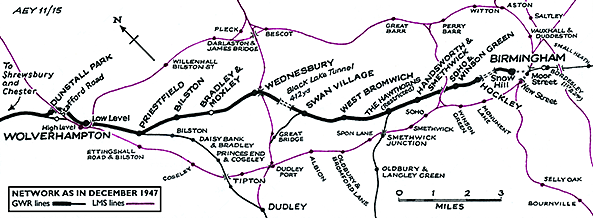
The station opened on 14 November 1854 as Wednesbury, even though the LNWR Wednesbury station had opened on 1 May 1850 no distinction between the two was made. The main building and accommodation were located on the Birmingham-bound (up) platform. Its design, seen also at Handsworth & Smethwick, Bilston Central and West Bromwich stations, was in an austere Classical style, imposing and highly distinctive. The style is not unlike some of those by the noted railway architect Francis Thompson, such as Holywell Junction, but it seems unlikely that he had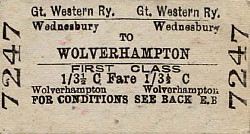 any direct influence on Wednesbury and its neighbours. A two-storey central block, containing the booking office on the ground floor, rose above single-storey wings in which waiting rooms were provided. The particular, somewhat dour, character of the building was given by the parapet (or blocking course) on the front and rear single-storey elevations and a cornice on the central section, almost concealing hipped roofs that lay behind them – a style associated with terraces with Classical pretensions in London, Bristol and Cheltenham. Although the overall construction was of brick, stone pilasters contributed gravitas to the upper storey of the central block, and stone was also employed in the cornices, parapets, quoins and the string course that surrounded the building. The openings on the upper floor and on the forecourt elevation of the wings were rectangular, with tablets below them bearing a simple geometric pattern; the central section of this elevation and all ground floor openings on the platform side were broad segmental arches apart from one centrally placed rectangular window. The arched openings were given stone quoins in a radial layout which added the only cheerful note to the otherwise sombre design. At the east end of the building was a short, single-storey extension with a lower roof-line than the adjoining wing repeating its style, even to the inclusion of a parapet. An awning stretched along the platform elevation of the building; it was a ridged structure carried on ornamental brackets. At some stage it was reduced to the length of the two-storey section of the building and the valance was removed. any direct influence on Wednesbury and its neighbours. A two-storey central block, containing the booking office on the ground floor, rose above single-storey wings in which waiting rooms were provided. The particular, somewhat dour, character of the building was given by the parapet (or blocking course) on the front and rear single-storey elevations and a cornice on the central section, almost concealing hipped roofs that lay behind them – a style associated with terraces with Classical pretensions in London, Bristol and Cheltenham. Although the overall construction was of brick, stone pilasters contributed gravitas to the upper storey of the central block, and stone was also employed in the cornices, parapets, quoins and the string course that surrounded the building. The openings on the upper floor and on the forecourt elevation of the wings were rectangular, with tablets below them bearing a simple geometric pattern; the central section of this elevation and all ground floor openings on the platform side were broad segmental arches apart from one centrally placed rectangular window. The arched openings were given stone quoins in a radial layout which added the only cheerful note to the otherwise sombre design. At the east end of the building was a short, single-storey extension with a lower roof-line than the adjoining wing repeating its style, even to the inclusion of a parapet. An awning stretched along the platform elevation of the building; it was a ridged structure carried on ornamental brackets. At some stage it was reduced to the length of the two-storey section of the building and the valance was removed.
The down platform had far humbler buildings, consisting of an awning of comparable length to its opposite number, but with small shelters at each end and a screen wall stretching between them.
Access to the station was via Great Western Street along which, by the 1870s, Wolverhampton Corporation trams operated. A small goods shed was initially provided, located to the rear of the up platform at the Birmingham end. This was supplemented, by the 1870s, with a larger goods station being constructed north-east of the station off Brook Lane. The proximity of the South Staffordshire line allowed co-operation between the GWR and LNWR with exchange sidings being set up south of the station; these were connected to the LNWR at Tipton Junction. Brunswick sidings were located between the exchange sidings and the rear of the Wolverhampton platform: these serviced the Brunswick Works which had been established on the site in 1840.
The mixed gauge line was converted to standard gauge during 1869.
Analysis of Bradshaw’s December 1895 timetable shows the station having a frequent service, in both directions on weekdays. Commencing at 6.23am in the Wolverhampton (down) direction and 7.07am in the Birmingham direction, final trains were 11.56pm and 11.30pm respectively with a  total of 20 down workings and 19 in the up direction. The Sunday service was a little sparse with eight in the Wolverhampton direction and nine in the Birmingham direction. Services were reduced during the First World War, as happened nationally, to release men for fighting and to create extra paths for the many additional trains associated with the war effort. Services began to return to normal, following the cessation of conflicts, and by July 1922 Bradshaw’s indicates there are 24 down (Wolverhampton) direction and 22 up services on weekdays, with nine down and ten up on Sunday. total of 20 down workings and 19 in the up direction. The Sunday service was a little sparse with eight in the Wolverhampton direction and nine in the Birmingham direction. Services were reduced during the First World War, as happened nationally, to release men for fighting and to create extra paths for the many additional trains associated with the war effort. Services began to return to normal, following the cessation of conflicts, and by July 1922 Bradshaw’s indicates there are 24 down (Wolverhampton) direction and 22 up services on weekdays, with nine down and ten up on Sunday.
 |
Bradshw's December 1895. To see a larger version click here
At the time of the Big Four ‘Grouping’ of 1 January 1923 Wednesbury remained under the control of the GWR.
The Second World War, again, brought about a reduction in the frequency of passenger trains as the railway network as a whole struggled to move troops and armaments associated with the war effort. By 1949 a war-weary general public was looking to the railways as a means of escape for a day trip or a longer holiday and the British Railways timetable of 1949 shows that this wish was 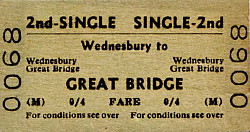 accommodated. Analysis of the workings in 1949 shows 23 services on Monday-to-Friday in the Wolverhampton direction, 24 on Saturday and 13 on Sunday. Looking at the workings in more detail reveals that nine returned passengers from holiday destinations including Penzance, Torquay, Paignton and Barmouth. In the up direction there were 23 Monday-to-Thursday workings, 25 on Friday, 27 on Saturday and 11 on Sunday. Eight of the weekday trains either ran directly, or conveyed through carriages, to various holiday destination in the south-west and Wales. Notable trains in the up direction would be the Friday-only 9.55pm departure which conveyed through carriages to Newquay and Penzance, arriving at 7.25am and 7.20am respectively: certainly a journey not for the faint hearted. Another Friday-only service for the intrepid traveller would have been the 10.56pm departure which conveyed through carriages to Torquay and Paignton, arriving 5.02am and 5.11am respectively. The balancing working for these two services departed the south-west around mid-morning arriving back at Wednesbury in the late evening. accommodated. Analysis of the workings in 1949 shows 23 services on Monday-to-Friday in the Wolverhampton direction, 24 on Saturday and 13 on Sunday. Looking at the workings in more detail reveals that nine returned passengers from holiday destinations including Penzance, Torquay, Paignton and Barmouth. In the up direction there were 23 Monday-to-Thursday workings, 25 on Friday, 27 on Saturday and 11 on Sunday. Eight of the weekday trains either ran directly, or conveyed through carriages, to various holiday destination in the south-west and Wales. Notable trains in the up direction would be the Friday-only 9.55pm departure which conveyed through carriages to Newquay and Penzance, arriving at 7.25am and 7.20am respectively: certainly a journey not for the faint hearted. Another Friday-only service for the intrepid traveller would have been the 10.56pm departure which conveyed through carriages to Torquay and Paignton, arriving 5.02am and 5.11am respectively. The balancing working for these two services departed the south-west around mid-morning arriving back at Wednesbury in the late evening.
The GWR installed electric lighting carried on the style of concrete posts more commonly associated with the Southern Railway.
On 1 January 1948 the railways were nationalised and Wednesbury came under the control of British Railways (BR) Western Region (WR). To distinguish it from the former LNWR/LMS station it was renamed Wednesbury Central on 19 July 1950, and presumably to remove any confusion that remained the other was suffixed ‘Town’ in 1960.
During the London Midland Region’s (LMR) electrification programme of the West Coast main line (WCML), started in 1958, the line saw an increase in passenger services as many extra trains were run via the WR metals to compensate for the reduction in services on the WCML. Although this did  not affect the service at Wednesbury it seemed to cement the former GWR route as still being a primary main line. Plans revealed by BR (WR) in the early 1960s for the rebuilding of Snow Hill and the introduction of new diesel Pullman services all pointed towards the future being bright. On 1 January 1963 boundaries for BR regions were re-drawn and Wednesbury station came under the control of BR (LMR), and with the completion of the electrification programme and the linking of the main line from Paddington to Birmingham New Street the route north of Snow Hill was considered secondary. not affect the service at Wednesbury it seemed to cement the former GWR route as still being a primary main line. Plans revealed by BR (WR) in the early 1960s for the rebuilding of Snow Hill and the introduction of new diesel Pullman services all pointed towards the future being bright. On 1 January 1963 boundaries for BR regions were re-drawn and Wednesbury station came under the control of BR (LMR), and with the completion of the electrification programme and the linking of the main line from Paddington to Birmingham New Street the route north of Snow Hill was considered secondary.
Prior to the LMR taking responsibility for the route the WR attempted to modernise some of the stations along the route. Totem nameplates and vitreous enamel running-in nameboards were installed and the waiting room on the Wolverhampton platform was demolished and replaced with a brick-built waiting shelter, similar to the shelters erected at Swan Village and Handsworth. This structure lacked ornamentation and consisted of a broad central entrance and windows either side. An awning with corrugated iron valances extended the full length of the building.
In 1966 BR (LMR) issued a proposal to close the Birmingham Snow Hill to Wolverhampton Low Level route, and all stations, in its entirety. In 1966 there were 24 trains in each direction to and from Wolverhampton, with around 2,000 people per day travelling on them (figure includes Snow Hill to Langley Green shuttle). Objections were posted to the Transport Users’ Consultative 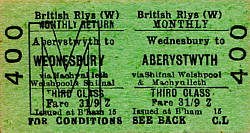 Committee (TUCC) and the case for closure was discussed on 20 September 1966. The recommendation of the TUCC was the line was to remain open as closure would cause ‘extreme hardship’. This ruling caused the LMR to change tactics with the announcement that as of 4 March 1967 the main line trains along the whole route would be withdrawn and freight trains diverted along other routes. On 15 November 1967 the Minister of Transport, Barbara Castle responded to BR’s application, refusing to allow the closure of the Wolverhampton to Snow Hill and the branch to Langley Green, but allowing the closure of the southern section from Snow Hill towards Stratford and Leamington. Committee (TUCC) and the case for closure was discussed on 20 September 1966. The recommendation of the TUCC was the line was to remain open as closure would cause ‘extreme hardship’. This ruling caused the LMR to change tactics with the announcement that as of 4 March 1967 the main line trains along the whole route would be withdrawn and freight trains diverted along other routes. On 15 November 1967 the Minister of Transport, Barbara Castle responded to BR’s application, refusing to allow the closure of the Wolverhampton to Snow Hill and the branch to Langley Green, but allowing the closure of the southern section from Snow Hill towards Stratford and Leamington.
In May 1968 the ‘Central’ suffix was removed from Wednesbury as the town’s other station had closed in 1964. Although BR policy was to pursue a go-ahead ‘Corporate Identity’ image with black-and-white signage, the extravagance of installing new signs was avoided; instead the LMR found some brown WR-coloured paint and obliterated ‘Central’ on the station nameboards. This cheapskate solution sufficed in the station’s dying years.
The LMR reduced the service level with the introduction of the May 1968 timetable in which Wednesbury saw just 24 down (Wolverhampton direction) services on Monday-to-Friday and 23 on Saturday, whilst the up workings consisted of 24 Monday-to-Saturday trains and the Sunday service was withdrawn. From May 1969 the service was reduced even further to just six workings each way on Monday-to-Friday and seven on Saturday as the LMR attempted to undermine the line’s viability by running as few trains as possible: the station at Wednesbury lost its complement of staff at the same time. Unlike many other stations along the route the platform buildings were retained following the withdrawal of station staff although the infrastructure slowly started to decay from a combination of vandalism, brought on by the absence of staff, and a general lack of 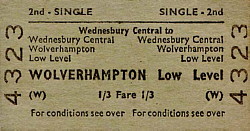 maintenance. In this condition Wednesbury Central station was unlikely to attract new, or even retain existing, passengers - but that was the intention. Between May 1969 and March 1972 the service remained at a constant level of six trains each way on Monday-to-Friday with one extra working on Saturday, in the early afternoon, to cater for shoppers wishing to travel to Birmingham or Wolverhampton. Passenger numbers had dwindled to one tenth of what they had been in 1966, and on 31 March 1971 the LMR made its move and posted closure notices for Wolverhampton Low Level to Birmingham Snow Hill, including the Langley Green shuttle; objections had to be received by 19 May 1971. The Transport Users’ Consultative Committee received 199 objections in total and on 25 May, they, along with representatives from BR and WMPTE (the Executive body of the WMPTA), inspected the route and all the stations, travelling from Snow Hill by train to Wolverhampton; ironically they returned by bus! A Public Hearing was held at the Rainbow Suite in Birmingham on 14 July 1971 to listen to objections and decide the future of the line. The statement issued by the TUCC could not have been clearer: ‘The addition of displaced rail passengers at these times would aggravate an already critical situation and would result in hardship for all concerned’. Nevertheless, on 24 January 1972 the Minister granted permission for closure to be implemented with a date quickly set for 4 March. On the final day trains were expected to be heavily patronised, so, instead of being the usual single car DMU the trains were strengthened to three-car units with BR issuing souvenir tickets. The final Wolverhampton-bound train called at Wednesbury at 6.08pm, the final Birmingham-bound service having departed at 5.58pm. maintenance. In this condition Wednesbury Central station was unlikely to attract new, or even retain existing, passengers - but that was the intention. Between May 1969 and March 1972 the service remained at a constant level of six trains each way on Monday-to-Friday with one extra working on Saturday, in the early afternoon, to cater for shoppers wishing to travel to Birmingham or Wolverhampton. Passenger numbers had dwindled to one tenth of what they had been in 1966, and on 31 March 1971 the LMR made its move and posted closure notices for Wolverhampton Low Level to Birmingham Snow Hill, including the Langley Green shuttle; objections had to be received by 19 May 1971. The Transport Users’ Consultative Committee received 199 objections in total and on 25 May, they, along with representatives from BR and WMPTE (the Executive body of the WMPTA), inspected the route and all the stations, travelling from Snow Hill by train to Wolverhampton; ironically they returned by bus! A Public Hearing was held at the Rainbow Suite in Birmingham on 14 July 1971 to listen to objections and decide the future of the line. The statement issued by the TUCC could not have been clearer: ‘The addition of displaced rail passengers at these times would aggravate an already critical situation and would result in hardship for all concerned’. Nevertheless, on 24 January 1972 the Minister granted permission for closure to be implemented with a date quickly set for 4 March. On the final day trains were expected to be heavily patronised, so, instead of being the usual single car DMU the trains were strengthened to three-car units with BR issuing souvenir tickets. The final Wolverhampton-bound train called at Wednesbury at 6.08pm, the final Birmingham-bound service having departed at 5.58pm.

BR Table 14 showing a service that had ceased to exist as per the bordered notice at its top.
In the early 1970s the LMR demolished the main building on the Birmingham-bound platform leaving a forlorn looking Wednesbury Central South signal box standing. The covered footbridge was retained as was the waiting shelter on the Wolverhampton platform.
The West Midlands Passenger Transport Authority (WMPTA) had long recognised the importance of the Wolverhampton to Birmingham Snow Hill route, although it became responsible for rail services only in 1972 so nothing could be done to stop the initial closure. On 31 October 1973 the Authority and its Executive body took steps to protect the trackbed from any future development so that some kind of public transport system could be reintroduced. The Authority’s 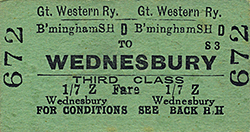 first success was the rebuilding of Snow Hill, in the late 1980s, and the introduction of heavy rail services north of the station to Stourbridge and Kidderminster in 1995. With the first Metro proposal having to be abandoned owing to public opinion and construction difficulties, the route of the former relief lines from Snow Hill to Swan Village and onward using the trackbed of the former double-track main line to Wolverhampton was chosen. The WMPTA announced this on 16 February 1988 and on 16 November 1989 an Act of Parliament was granted for its construction. It was not until 3 August 1995 that the contract for construction was let to Altram, a consortium of Ansaldo and John Laing, with construction commencing on 13 November. The final section of track was laid on 4 February 1998 with public services beginning on 31 May 1999. The station site and that of the transfer sidings were chosen to accommodate the maintenance facility for the new tram network as a large parcel of land was available. first success was the rebuilding of Snow Hill, in the late 1980s, and the introduction of heavy rail services north of the station to Stourbridge and Kidderminster in 1995. With the first Metro proposal having to be abandoned owing to public opinion and construction difficulties, the route of the former relief lines from Snow Hill to Swan Village and onward using the trackbed of the former double-track main line to Wolverhampton was chosen. The WMPTA announced this on 16 February 1988 and on 16 November 1989 an Act of Parliament was granted for its construction. It was not until 3 August 1995 that the contract for construction was let to Altram, a consortium of Ansaldo and John Laing, with construction commencing on 13 November. The final section of track was laid on 4 February 1998 with public services beginning on 31 May 1999. The station site and that of the transfer sidings were chosen to accommodate the maintenance facility for the new tram network as a large parcel of land was available.
Today a small section of wall from the original station still exists, to the rear of the Birmingham platform, at the current Wednesbury tram stop. There is no further evidence that a station or the transfer sidings ever existed.
Tickets from Michael Stewart & Brian Halford, route map by Alan Young,
Totem from Richad Furness
Sources:
- Bradshaw's Railway Guide December 1895 - Middleton Press
- Forgotten Railways: Volume 10, The West Midlands - Rex Christinsen - David & Charles Publishing 1985
- A Regional History of the Railways of Great Britain - Volume 7 The West Midlands - Rex Christiansen - David St John Thomas Publisher 1991
- A Century of Railways around Birmingham and the West Midlands Vol 1,2 & 3 - John Boynton - Mid England Books Publisher 1999
- From Main Line To Metro - John Boynton - Mid England Books 2001
- Railway Passenger Station in Great Britain - A Chronology - Michael Quick - Railway & Canal Historical Society 2009
To see the
other stations on the Birmingham Snow Hill - Chester General line
click on the station name: Birmingham Snow Hill, Hockley, Winson Green, Handsworth, The Hawthorns, West Bromwich, Swan Village, Bradley & Moxley, Bilston, Priestfield, Wolverhampton Low Level, Dunstall Park, Stafford Road,
New Hadley Halt, Admaston Halt, Walcot, Upton Magna, Abbey Foregate, Shrewsbury S&C, Leaton, Oldwoods Halt, Baschurch, Stanwardine Halt, Haughton Halt, Rednal & West Felton, Whittington Low Level, Weston Rhyn, Whitehurst Halt, Rhosymedre, Rhosymedre Halt, Wynville Halt, Rhos,
Johnstown & Hafod, Rhosrobin Halt, Gresford, Rossett,
Pulford, Balderton and Saltney
|


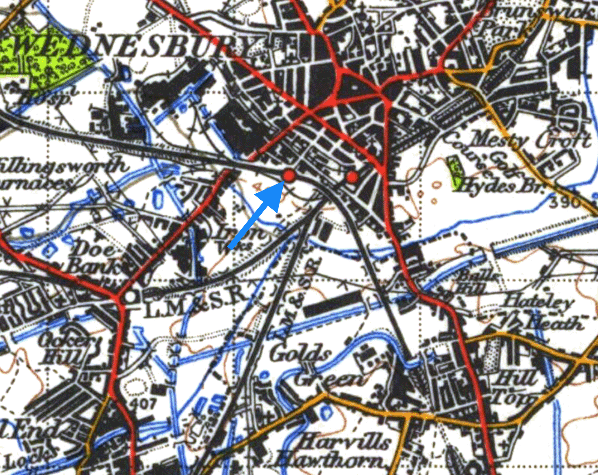
 The 1876 1:2500 OS map showing the Great Western and LNWR goods facilities that were expanding within the area. Wagons could be transferred between the LNWR's South Staffordshire line and the GWR line via the joint Exchange Sidings.
The 1876 1:2500 OS map showing the Great Western and LNWR goods facilities that were expanding within the area. Wagons could be transferred between the LNWR's South Staffordshire line and the GWR line via the joint Exchange Sidings.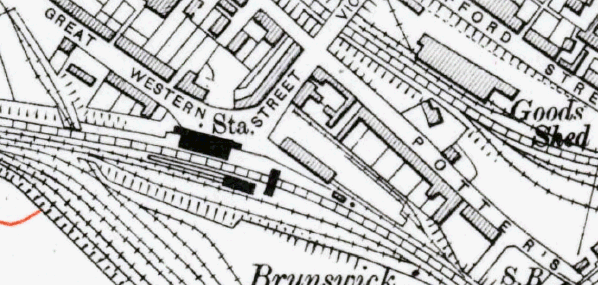 The 1912 six inch map.
The 1912 six inch map.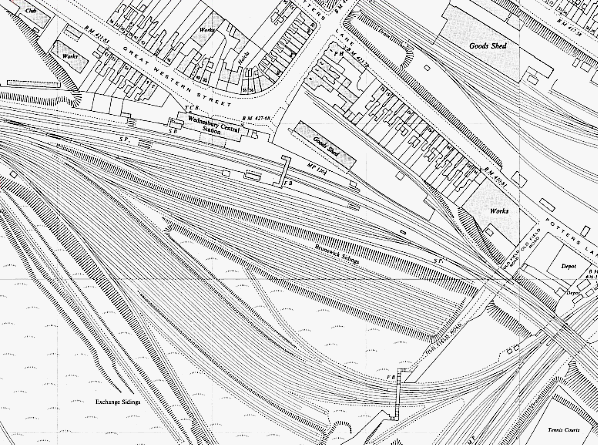 The 1965 1:2500 OS Plan shows just how much freight activity was concentrated on the area to the south of the station with a mass of siding space.
The 1965 1:2500 OS Plan shows just how much freight activity was concentrated on the area to the south of the station with a mass of siding space.
totem.gif)

 any direct influence on Wednesbury and its neighbours. A two-storey central block, containing the booking office on the ground floor, rose above single-storey wings in which waiting rooms were provided. The particular, somewhat dour, character of the building was given by the parapet (or blocking course) on the front and rear single-storey elevations and a cornice on the central section, almost concealing hipped roofs that lay behind them – a style associated with terraces with Classical pretensions in London, Bristol and Cheltenham. Although the overall construction was of brick, stone pilasters contributed gravitas to the upper storey of the central block, and stone was also employed in the cornices, parapets, quoins and the string course that surrounded the building. The openings on the upper floor and on the forecourt elevation of the wings were rectangular, with tablets below them bearing a simple geometric pattern; the central section of this elevation and all ground floor openings on the platform side were broad segmental arches apart from one centrally placed rectangular window. The arched openings were given stone quoins in a radial layout which added the only cheerful note to the otherwise sombre design. At the east end of the building was a short, single-storey extension with a lower roof-line than the adjoining wing repeating its style, even to the inclusion of a parapet. An awning stretched along the platform elevation of the building; it was a ridged structure carried on ornamental brackets. At some stage it was reduced to the length of the two-storey section of the building and the valance was removed.
any direct influence on Wednesbury and its neighbours. A two-storey central block, containing the booking office on the ground floor, rose above single-storey wings in which waiting rooms were provided. The particular, somewhat dour, character of the building was given by the parapet (or blocking course) on the front and rear single-storey elevations and a cornice on the central section, almost concealing hipped roofs that lay behind them – a style associated with terraces with Classical pretensions in London, Bristol and Cheltenham. Although the overall construction was of brick, stone pilasters contributed gravitas to the upper storey of the central block, and stone was also employed in the cornices, parapets, quoins and the string course that surrounded the building. The openings on the upper floor and on the forecourt elevation of the wings were rectangular, with tablets below them bearing a simple geometric pattern; the central section of this elevation and all ground floor openings on the platform side were broad segmental arches apart from one centrally placed rectangular window. The arched openings were given stone quoins in a radial layout which added the only cheerful note to the otherwise sombre design. At the east end of the building was a short, single-storey extension with a lower roof-line than the adjoining wing repeating its style, even to the inclusion of a parapet. An awning stretched along the platform elevation of the building; it was a ridged structure carried on ornamental brackets. At some stage it was reduced to the length of the two-storey section of the building and the valance was removed.  total of 20 down workings and 19 in the up direction. The Sunday service was a little sparse with eight in the Wolverhampton direction and nine in the Birmingham direction. Services were reduced during the First World War, as happened nationally, to release men for fighting and to create extra paths for the many additional trains associated with the war effort. Services began to return to normal, following the cessation of conflicts, and by July 1922 Bradshaw’s indicates there are 24 down (Wolverhampton) direction and 22 up services on weekdays, with nine down and ten up on Sunday.
total of 20 down workings and 19 in the up direction. The Sunday service was a little sparse with eight in the Wolverhampton direction and nine in the Birmingham direction. Services were reduced during the First World War, as happened nationally, to release men for fighting and to create extra paths for the many additional trains associated with the war effort. Services began to return to normal, following the cessation of conflicts, and by July 1922 Bradshaw’s indicates there are 24 down (Wolverhampton) direction and 22 up services on weekdays, with nine down and ten up on Sunday.
 accommodated. Analysis of the workings in 1949 shows 23 services on Monday-to-Friday in the Wolverhampton direction, 24 on Saturday and 13 on Sunday. Looking at the workings in more detail reveals that nine returned passengers from holiday destinations including Penzance, Torquay, Paignton and Barmouth. In the up direction there were 23 Monday-to-Thursday workings, 25 on Friday, 27 on Saturday and 11 on Sunday. Eight of the weekday trains either ran directly, or conveyed through carriages, to various holiday destination in the south-west and Wales. Notable trains in the up direction would be the Friday-only 9.55pm departure which conveyed through carriages to Newquay and Penzance, arriving at 7.25am and 7.20am respectively: certainly a journey not for the faint hearted. Another Friday-only service for the intrepid traveller would have been the 10.56pm departure which conveyed through carriages to Torquay and Paignton, arriving 5.02am and 5.11am respectively. The balancing working for these two services departed the south-west around mid-morning arriving back at Wednesbury in the late evening.
accommodated. Analysis of the workings in 1949 shows 23 services on Monday-to-Friday in the Wolverhampton direction, 24 on Saturday and 13 on Sunday. Looking at the workings in more detail reveals that nine returned passengers from holiday destinations including Penzance, Torquay, Paignton and Barmouth. In the up direction there were 23 Monday-to-Thursday workings, 25 on Friday, 27 on Saturday and 11 on Sunday. Eight of the weekday trains either ran directly, or conveyed through carriages, to various holiday destination in the south-west and Wales. Notable trains in the up direction would be the Friday-only 9.55pm departure which conveyed through carriages to Newquay and Penzance, arriving at 7.25am and 7.20am respectively: certainly a journey not for the faint hearted. Another Friday-only service for the intrepid traveller would have been the 10.56pm departure which conveyed through carriages to Torquay and Paignton, arriving 5.02am and 5.11am respectively. The balancing working for these two services departed the south-west around mid-morning arriving back at Wednesbury in the late evening. not affect the service at Wednesbury it seemed to cement the former GWR route as still being a primary main line. Plans revealed by BR (WR) in the early 1960s for the rebuilding of Snow Hill and the introduction of new diesel Pullman services all pointed towards the future being bright. On 1 January 1963 boundaries for BR regions were re-drawn and Wednesbury station came under the control of BR (LMR), and with the completion of the electrification programme and the linking of the main line from Paddington to Birmingham New Street the route north of Snow Hill was considered secondary.
not affect the service at Wednesbury it seemed to cement the former GWR route as still being a primary main line. Plans revealed by BR (WR) in the early 1960s for the rebuilding of Snow Hill and the introduction of new diesel Pullman services all pointed towards the future being bright. On 1 January 1963 boundaries for BR regions were re-drawn and Wednesbury station came under the control of BR (LMR), and with the completion of the electrification programme and the linking of the main line from Paddington to Birmingham New Street the route north of Snow Hill was considered secondary.  Committee (TUCC) and the case for closure was discussed on 20 September 1966. The recommendation of the TUCC was the line was to remain open as closure would cause ‘extreme hardship’. This ruling caused the LMR to change tactics with the announcement that as of 4 March 1967 the main line trains along the whole route would be withdrawn and freight trains diverted along other routes. On 15 November 1967 the Minister of Transport, Barbara Castle responded to BR’s application, refusing to allow the closure of the Wolverhampton to Snow Hill and the branch to Langley Green, but allowing the closure of the southern section from Snow Hill towards Stratford and Leamington.
Committee (TUCC) and the case for closure was discussed on 20 September 1966. The recommendation of the TUCC was the line was to remain open as closure would cause ‘extreme hardship’. This ruling caused the LMR to change tactics with the announcement that as of 4 March 1967 the main line trains along the whole route would be withdrawn and freight trains diverted along other routes. On 15 November 1967 the Minister of Transport, Barbara Castle responded to BR’s application, refusing to allow the closure of the Wolverhampton to Snow Hill and the branch to Langley Green, but allowing the closure of the southern section from Snow Hill towards Stratford and Leamington.  maintenance. In this condition Wednesbury Central station was unlikely to attract new, or even retain existing, passengers - but that was the intention. Between May 1969 and March 1972 the service remained at a constant level of six trains each way on Monday-to-Friday with one extra working on Saturday, in the early afternoon, to cater for shoppers wishing to travel to Birmingham or Wolverhampton. Passenger numbers had dwindled to one tenth of what they had been in 1966, and on 31 March 1971 the LMR made its move and posted closure notices for Wolverhampton Low Level to Birmingham Snow Hill, including the Langley Green shuttle; objections had to be received by 19 May 1971. The Transport Users’ Consultative Committee received 199 objections in total and on 25 May, they, along with representatives from BR and WMPTE (the Executive body of the WMPTA), inspected the route and all the stations, travelling from Snow Hill by train to Wolverhampton; ironically they returned by bus! A Public Hearing was held at the Rainbow Suite in Birmingham on 14 July 1971 to listen to objections and decide the future of the line. The statement issued by the TUCC could not have been clearer: ‘The addition of displaced rail passengers at these times would aggravate an already critical situation and would result in hardship for all concerned’. Nevertheless, on 24 January 1972 the Minister granted permission for closure to be implemented with a date quickly set for 4 March. On the final day trains were expected to be heavily patronised, so, instead of being the usual single car DMU the trains were strengthened to three-car units with BR issuing souvenir tickets. The final Wolverhampton-bound train called at Wednesbury at 6.08pm, the final Birmingham-bound service having departed at 5.58pm.
maintenance. In this condition Wednesbury Central station was unlikely to attract new, or even retain existing, passengers - but that was the intention. Between May 1969 and March 1972 the service remained at a constant level of six trains each way on Monday-to-Friday with one extra working on Saturday, in the early afternoon, to cater for shoppers wishing to travel to Birmingham or Wolverhampton. Passenger numbers had dwindled to one tenth of what they had been in 1966, and on 31 March 1971 the LMR made its move and posted closure notices for Wolverhampton Low Level to Birmingham Snow Hill, including the Langley Green shuttle; objections had to be received by 19 May 1971. The Transport Users’ Consultative Committee received 199 objections in total and on 25 May, they, along with representatives from BR and WMPTE (the Executive body of the WMPTA), inspected the route and all the stations, travelling from Snow Hill by train to Wolverhampton; ironically they returned by bus! A Public Hearing was held at the Rainbow Suite in Birmingham on 14 July 1971 to listen to objections and decide the future of the line. The statement issued by the TUCC could not have been clearer: ‘The addition of displaced rail passengers at these times would aggravate an already critical situation and would result in hardship for all concerned’. Nevertheless, on 24 January 1972 the Minister granted permission for closure to be implemented with a date quickly set for 4 March. On the final day trains were expected to be heavily patronised, so, instead of being the usual single car DMU the trains were strengthened to three-car units with BR issuing souvenir tickets. The final Wolverhampton-bound train called at Wednesbury at 6.08pm, the final Birmingham-bound service having departed at 5.58pm. 
 first success was the rebuilding of Snow Hill, in the late 1980s, and the introduction of heavy rail services north of the station to Stourbridge and Kidderminster in 1995. With the first Metro proposal having to be abandoned owing to public opinion and construction difficulties, the route of the former relief lines from Snow Hill to Swan Village and onward using the trackbed of the former double-track main line to Wolverhampton was chosen. The WMPTA announced this on 16 February 1988 and on 16 November 1989 an Act of Parliament was granted for its construction. It was not until 3 August 1995 that the contract for construction was let to Altram, a consortium of Ansaldo and John Laing, with construction commencing on 13 November. The final section of track was laid on 4 February 1998 with public services beginning on 31 May 1999. The station site and that of the transfer sidings were chosen to accommodate the maintenance facility for the new tram network as a large parcel of land was available.
first success was the rebuilding of Snow Hill, in the late 1980s, and the introduction of heavy rail services north of the station to Stourbridge and Kidderminster in 1995. With the first Metro proposal having to be abandoned owing to public opinion and construction difficulties, the route of the former relief lines from Snow Hill to Swan Village and onward using the trackbed of the former double-track main line to Wolverhampton was chosen. The WMPTA announced this on 16 February 1988 and on 16 November 1989 an Act of Parliament was granted for its construction. It was not until 3 August 1995 that the contract for construction was let to Altram, a consortium of Ansaldo and John Laing, with construction commencing on 13 November. The final section of track was laid on 4 February 1998 with public services beginning on 31 May 1999. The station site and that of the transfer sidings were chosen to accommodate the maintenance facility for the new tram network as a large parcel of land was available.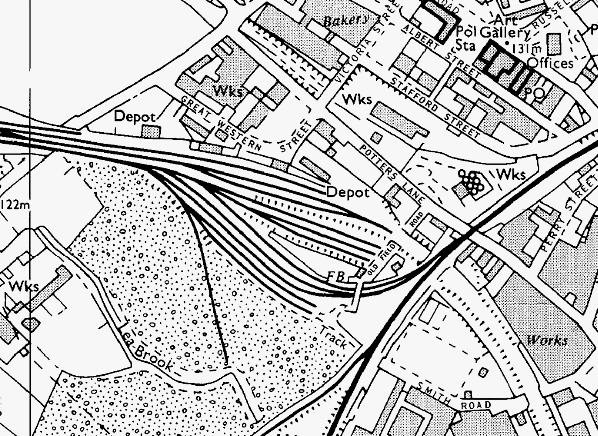
 A Chruchward 47xx Class 2-8-0 heavy freight locomotive heads in the Wolverhampton direction in December 1959 observed by a lone passenger on the Birmingham bound platform.
A Chruchward 47xx Class 2-8-0 heavy freight locomotive heads in the Wolverhampton direction in December 1959 observed by a lone passenger on the Birmingham bound platform.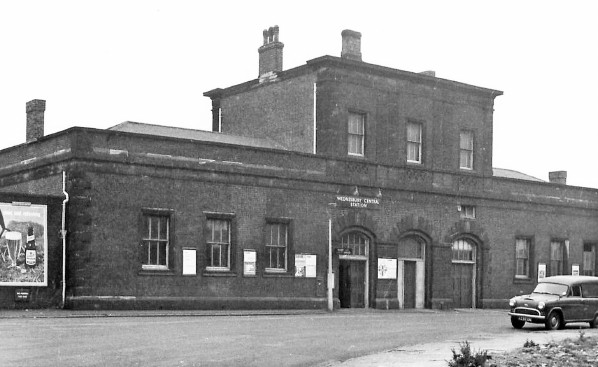
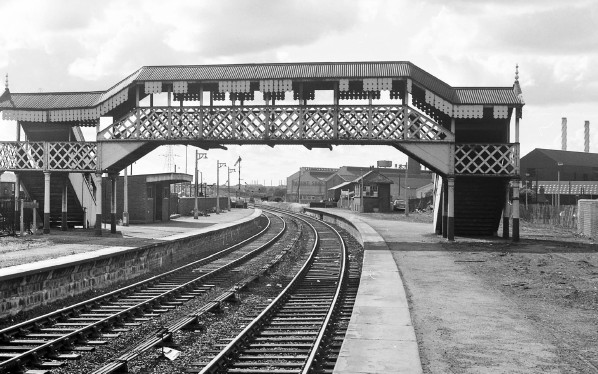
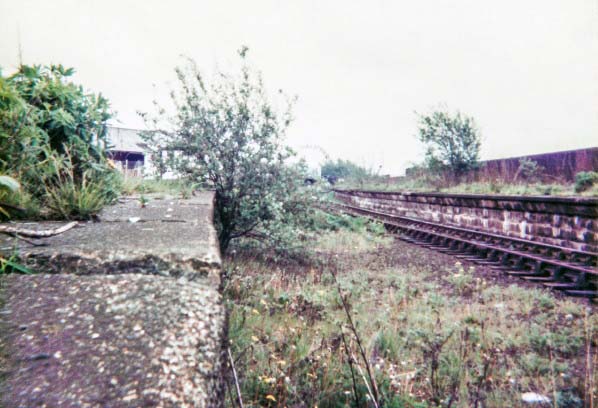 Looking towards Birmingham on 22 May 1983 with the station having been closed for some 11 years. Nature has taken over the platform surfaces although the down Wolverhampton line remains it being used as a siding at the time.
Looking towards Birmingham on 22 May 1983 with the station having been closed for some 11 years. Nature has taken over the platform surfaces although the down Wolverhampton line remains it being used as a siding at the time.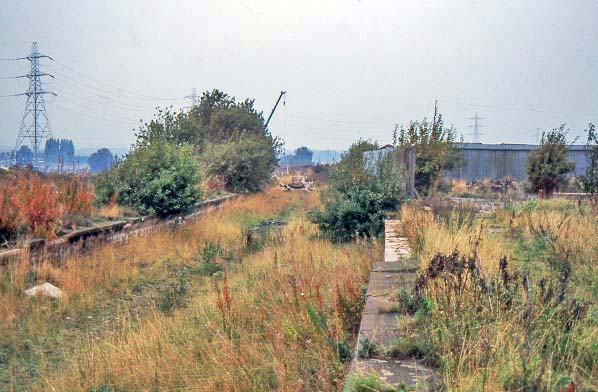 Looking in the Wolverhampton direction on 11 October 1995 the whole station site would be transformed within the next two years to incorporate a tram stop and the Midland Metro workshops.
Looking in the Wolverhampton direction on 11 October 1995 the whole station site would be transformed within the next two years to incorporate a tram stop and the Midland Metro workshops.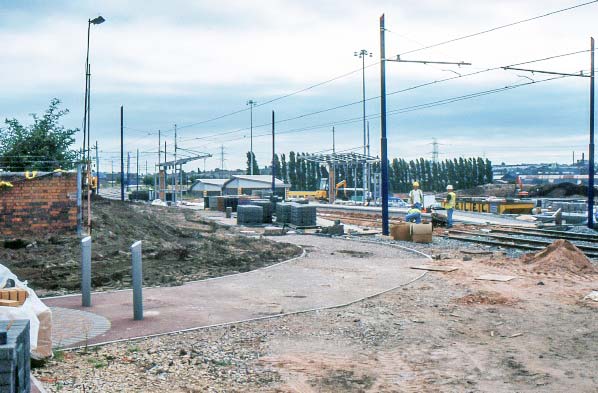 Looking from Great Western Street on 8 September 1997 with work well advanced on construction of the new tram stop and the workshop facility.
Looking from Great Western Street on 8 September 1997 with work well advanced on construction of the new tram stop and the workshop facility. Looking across Great Western Street on 5 November 2016 as a Birmingham bound tram runs through, the large workshop facility dominates the scene.
Looking across Great Western Street on 5 November 2016 as a Birmingham bound tram runs through, the large workshop facility dominates the scene.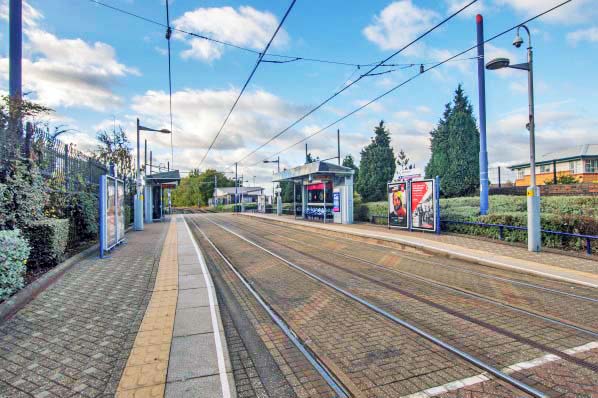 Looking in the Birmingham direction from the current Wednesbury Great Western Street tram stop on 5 November 2016 from, what would have been, the Birmingham bound platform.
Looking in the Birmingham direction from the current Wednesbury Great Western Street tram stop on 5 November 2016 from, what would have been, the Birmingham bound platform.
 Home Page
Home Page